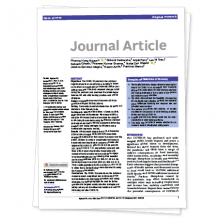Journal article
Jul 07 2015

Scaling up impact on nutrition: What will it take?
This paper included a literature review and four case studies (including A&T work in Bangladesh) on large-scale nutrition programs with proven impact.
Journal article
Dec 01 2014

Incorporating elements of social franchising in government health services improves the quality of infant and young child feeding counselling services at commune health centres in Viet Nam (Nguyen, P.H., 2014. Health Policy and Planning)
This study assessed the effects of incorporating social franchising on infant and young child feeding (IYCF) counseling facilities and services.
Journal article
Oct 14 2014

Small grants program: Scripted messages delivered by nurses and radio changed beliefs, attitudes, intentions, and behaviors regarding infant and young child feeding in Mexico
This study aimed to evaluate whether an infant and young child feeding (IYCF) nutrition communication strategy using nurses deliverable radio messages changed beliefs, attitudes, social norms, intentions, and behaviors related to breastfeeding (BF), dietary diversity, and food consistency.
Journal article
Oct 01 2014

Program impact pathway analysis of a social franchise model shows potential to improve infant and young child feeding practices in Viet Nam (Nguyen PH., 2014. Journal of Nutrition)
By mapping the mechanisms through which interventions are expected to achieve impact, program impact pathway (PIP) analysis lays out the theoretical causal links between program activities, outcomes, and impacts.
Journal article
May 01 2014

Linear growth increased in young children in an urban slum of Haiti: a randomized controlled trial of a lipid-based nutrient supplement (Iannotti I., 2014. American Journal of Clinical Nutrition)
The aim of this project was to test the efficacy of a lipid-based nutrient supplement (LNS) on infants 6 to 11 months in Haiti. The LNS provided 108 kcal and vitamin A, vitamin B-12, iron, and zinc (80 % of the recommended amounts).
Journal article
Dec 13 2013

Handwashing before food preparation and child feeding: a missed opportunity for hygiene promotion (Nizame FA., 2013. American Journal of Tropical Medicine and Hygiene)
Enteric diseases are often caused by poor hygiene and can contribute to stunting. In Bangladesh preparing food, serving food, feeding children, and eating food with bare hands is a common practice, yet most handwashing promotion has focused on fecal contact.

